In The Age Of Handheld Games
Before There Was A Gameboy
During my 4 1/2 years of being a resident of St. Vincent's Home for Children in Fall River, MA in the early 1980s, if there was one thing that made being there a bit bearable, it was that handheld games tended to proliferate among the students even though there were a few lucky ones who happened to own videogame systems like the Atari 2600 and the ColecoVision. Handheld games represented in part the ultimate freedom from the rather infrequent visits to the arcade and the home visits where my Atari 2600 collection would only start with grow with marked-down game cartridges around the summer of 1983. Though graphically and soundwise they could never compare to the likes of the later-released Nintendo Gameboy series of systems, handheld games still provided one with all the gaming they could possibly handle on the go, as long as they had a fresh supply of batteries to keep the action going.
While this article may not cover every handheld game that has ever been produced in the early 1980s, I will focus my attention on the ones made or manufactured by the most popular companies of that time period:
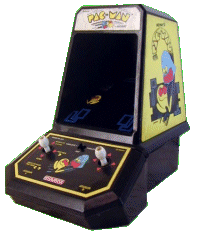 Coleco -- Before they made a shortly-lived success out of their "one-hit wonder" ColecoVision game system, Coleco was already in the business of developing handheld games, beginning with the likes of Electronic Quarterback and their Head To Head series of sports games that rivaled the output of Mattel's own set of handheld sports games. However, it was with the initial release of their adaptations of coin-op games like Pac-Man, Galaxian, Donkey Kong, Frogger, and Galaxian did we see Coleco giving such incredible attention to detail, like making the casings of their games mimic the design of the original arcade machines they came in. This versimilitude even extended into the making of Zaxxon, which featured 2 LED displays reflected onto a mirror to simulate the diagonally-scrolling isometric 3D view of the original arcade game.
Coleco -- Before they made a shortly-lived success out of their "one-hit wonder" ColecoVision game system, Coleco was already in the business of developing handheld games, beginning with the likes of Electronic Quarterback and their Head To Head series of sports games that rivaled the output of Mattel's own set of handheld sports games. However, it was with the initial release of their adaptations of coin-op games like Pac-Man, Galaxian, Donkey Kong, Frogger, and Galaxian did we see Coleco giving such incredible attention to detail, like making the casings of their games mimic the design of the original arcade machines they came in. This versimilitude even extended into the making of Zaxxon, which featured 2 LED displays reflected onto a mirror to simulate the diagonally-scrolling isometric 3D view of the original arcade game.
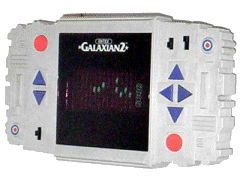 Entex -- This company probably developed the most handheld games based on arcade machines, including those that were either the most challenging to reproduce, like Defender and Stargate, or were the least-popular coin-op games, like Turtles and Spiders. Some of their handheld reproductions of arcade games even included an interesting 2-player option where the opposing player could play the enemy character (like the aliens of Galaxian or the ghosts of Pac-Man). Also interesting to note was their attempt to produce a programmable portable game system called the Adventure Vision, which used a red LED dot screen to display the graphics. However, there were only four cartridges produced for this system: Defender, Space Force (an Asteroids clone), Super Cobra, and Turtles.
Entex -- This company probably developed the most handheld games based on arcade machines, including those that were either the most challenging to reproduce, like Defender and Stargate, or were the least-popular coin-op games, like Turtles and Spiders. Some of their handheld reproductions of arcade games even included an interesting 2-player option where the opposing player could play the enemy character (like the aliens of Galaxian or the ghosts of Pac-Man). Also interesting to note was their attempt to produce a programmable portable game system called the Adventure Vision, which used a red LED dot screen to display the graphics. However, there were only four cartridges produced for this system: Defender, Space Force (an Asteroids clone), Super Cobra, and Turtles.
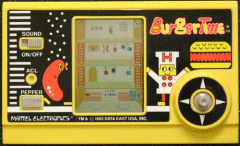 Mattel -- Right alongside their popular Intellivision game console, Mattel's electronics division also produced a series of handheld sports games, some of which have been re-released in this day and age. As far as arcade game reproductions, Mattel had only Armor Attack and Burgertime, which were done as pocket-sized games. I've only played Burgertime, but from what I've played, it's a pretty good adaptation. Mattel also developed an electronic Dungeons & Dragons game, which was later recycled as the Masters of the Universe game featuring He-Man and Skeletor in the place of both the warrior and the dragon of the earlier game.
Mattel -- Right alongside their popular Intellivision game console, Mattel's electronics division also produced a series of handheld sports games, some of which have been re-released in this day and age. As far as arcade game reproductions, Mattel had only Armor Attack and Burgertime, which were done as pocket-sized games. I've only played Burgertime, but from what I've played, it's a pretty good adaptation. Mattel also developed an electronic Dungeons & Dragons game, which was later recycled as the Masters of the Universe game featuring He-Man and Skeletor in the place of both the warrior and the dragon of the earlier game.
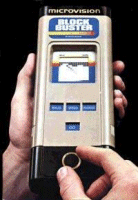 Milton Bradley -- Their only entry into the handheld games category was, surprisingly, a programmable handheld game system called the MicroVision, which had games that could be "snapped on" to the front of the unit, each featuring their own control panels and screen overlays. Most of their games were relatively simplistic; a few arcade-style games like Breakout and pinball, a slots game, a Connect Four game, a baseball game, and some others. Of course, part of what made these games rather simplistic was the system's rather blocky LCD graphics display and limited sound capability. Anyway, this was what the formerly independent board game company supported until the time GCE gave Milton Bradley the license to manufacture their Vectrex arcade game system.
Milton Bradley -- Their only entry into the handheld games category was, surprisingly, a programmable handheld game system called the MicroVision, which had games that could be "snapped on" to the front of the unit, each featuring their own control panels and screen overlays. Most of their games were relatively simplistic; a few arcade-style games like Breakout and pinball, a slots game, a Connect Four game, a baseball game, and some others. Of course, part of what made these games rather simplistic was the system's rather blocky LCD graphics display and limited sound capability. Anyway, this was what the formerly independent board game company supported until the time GCE gave Milton Bradley the license to manufacture their Vectrex arcade game system.
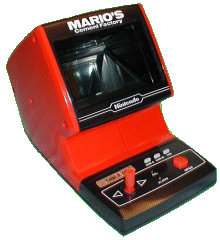 Nintendo -- Probably best known for all the Game & Watch pocket games that have been pumped out even right alongside the release of the Nintendo Entertainment System. However, they also released three tabletop games, each of which had light filters that required them to be played with an exterior light source so they couldn't be played in the dark. Of these three games, Mario's Cement Factory is the most intriguing, since the object of the game is to keep the cement constantly flowing into the trucks without having an overflow dumping on the drivers...and part of the challenge was that Mario had to go from elevator to elevator to travel from one side of the screen to the other to keep up with the cement. The other two games in this format were Popeye (a simplistic fighting game of sorts) and Snoopy (a reflex game where you must stop the notes Schroeder plays on his piano from disturbing Woodstock and his friends sleeping in their nests).
Nintendo -- Probably best known for all the Game & Watch pocket games that have been pumped out even right alongside the release of the Nintendo Entertainment System. However, they also released three tabletop games, each of which had light filters that required them to be played with an exterior light source so they couldn't be played in the dark. Of these three games, Mario's Cement Factory is the most intriguing, since the object of the game is to keep the cement constantly flowing into the trucks without having an overflow dumping on the drivers...and part of the challenge was that Mario had to go from elevator to elevator to travel from one side of the screen to the other to keep up with the cement. The other two games in this format were Popeye (a simplistic fighting game of sorts) and Snoopy (a reflex game where you must stop the notes Schroeder plays on his piano from disturbing Woodstock and his friends sleeping in their nests).
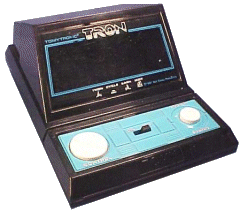 Tomy -- This company developed a whole lot of handheld games, most of which were sold by the likes of Radio Shack and foreign companies overseas. However, the ones which had the primary focus in America were their four arcade adaptation games -- Cosmic Combat (which was a Space Invaders clone), Pac-Man, Scramble, and the one I personally owned, Tron. While these games seemed less developed than the likes of, say, Coleco's or Entex's handheld counterparts, they still were just as much fun to play. Pac-Man in particular had a very unique yellow casing in the shape of a Pac-Man, and Tron had a translucent black case top through which you could see a faux circuit board (probably to remind players of the movie character's computer world origins). There were also three 3D-style action games produced by Tomy -- Planet Zeon, Sky Attack, and Thundering Turbo -- where the images were stereoscoped to give players the illusion of three dimensions.
Tomy -- This company developed a whole lot of handheld games, most of which were sold by the likes of Radio Shack and foreign companies overseas. However, the ones which had the primary focus in America were their four arcade adaptation games -- Cosmic Combat (which was a Space Invaders clone), Pac-Man, Scramble, and the one I personally owned, Tron. While these games seemed less developed than the likes of, say, Coleco's or Entex's handheld counterparts, they still were just as much fun to play. Pac-Man in particular had a very unique yellow casing in the shape of a Pac-Man, and Tron had a translucent black case top through which you could see a faux circuit board (probably to remind players of the movie character's computer world origins). There were also three 3D-style action games produced by Tomy -- Planet Zeon, Sky Attack, and Thundering Turbo -- where the images were stereoscoped to give players the illusion of three dimensions.
While we haven't seen the last of the "self-contained" handheld games being produced even to this day and age, the appearance of the Gameboy clearly marked the point when gamers now had a choice of getting a high-quality handheld system that could play multiple games or getting one that would only play one game, using visual technology that was as limited as the handhelds and portables of the early 1980s. While I may seem biased over getting a handheld game system that would let me play multiple games rather than a single game, I don't see much of a problem for those who prefer the single-game units instead. For those who don't have the space for accumulating such a collection of self-contained game units, classic and/or modern, there are handheld game simulators for the PCs that can be found at certain websites. I'm just wondering if someone would be daring to try doing a retrofit job of putting a Gameboy Advance within an old Coleco Pac-Man tabletop casing, to really push the envelope of versimilitude when it comes to portable classic gaming.
 Coleco -- Before they made a shortly-lived success out of their "one-hit wonder" ColecoVision game system, Coleco was already in the business of developing handheld games, beginning with the likes of Electronic Quarterback and their Head To Head series of sports games that rivaled the output of Mattel's own set of handheld sports games. However, it was with the initial release of their adaptations of coin-op games like Pac-Man, Galaxian, Donkey Kong, Frogger, and Galaxian did we see Coleco giving such incredible attention to detail, like making the casings of their games mimic the design of the original arcade machines they came in. This versimilitude even extended into the making of Zaxxon, which featured 2 LED displays reflected onto a mirror to simulate the diagonally-scrolling isometric 3D view of the original arcade game.
Coleco -- Before they made a shortly-lived success out of their "one-hit wonder" ColecoVision game system, Coleco was already in the business of developing handheld games, beginning with the likes of Electronic Quarterback and their Head To Head series of sports games that rivaled the output of Mattel's own set of handheld sports games. However, it was with the initial release of their adaptations of coin-op games like Pac-Man, Galaxian, Donkey Kong, Frogger, and Galaxian did we see Coleco giving such incredible attention to detail, like making the casings of their games mimic the design of the original arcade machines they came in. This versimilitude even extended into the making of Zaxxon, which featured 2 LED displays reflected onto a mirror to simulate the diagonally-scrolling isometric 3D view of the original arcade game. Entex -- This company probably developed the most handheld games based on arcade machines, including those that were either the most challenging to reproduce, like Defender and Stargate, or were the least-popular coin-op games, like Turtles and Spiders. Some of their handheld reproductions of arcade games even included an interesting 2-player option where the opposing player could play the enemy character (like the aliens of Galaxian or the ghosts of Pac-Man). Also interesting to note was their attempt to produce a programmable portable game system called the Adventure Vision, which used a red LED dot screen to display the graphics. However, there were only four cartridges produced for this system: Defender, Space Force (an Asteroids clone), Super Cobra, and Turtles.
Entex -- This company probably developed the most handheld games based on arcade machines, including those that were either the most challenging to reproduce, like Defender and Stargate, or were the least-popular coin-op games, like Turtles and Spiders. Some of their handheld reproductions of arcade games even included an interesting 2-player option where the opposing player could play the enemy character (like the aliens of Galaxian or the ghosts of Pac-Man). Also interesting to note was their attempt to produce a programmable portable game system called the Adventure Vision, which used a red LED dot screen to display the graphics. However, there were only four cartridges produced for this system: Defender, Space Force (an Asteroids clone), Super Cobra, and Turtles. Mattel -- Right alongside their popular Intellivision game console, Mattel's electronics division also produced a series of handheld sports games, some of which have been re-released in this day and age. As far as arcade game reproductions, Mattel had only Armor Attack and Burgertime, which were done as pocket-sized games. I've only played Burgertime, but from what I've played, it's a pretty good adaptation. Mattel also developed an electronic Dungeons & Dragons game, which was later recycled as the Masters of the Universe game featuring He-Man and Skeletor in the place of both the warrior and the dragon of the earlier game.
Mattel -- Right alongside their popular Intellivision game console, Mattel's electronics division also produced a series of handheld sports games, some of which have been re-released in this day and age. As far as arcade game reproductions, Mattel had only Armor Attack and Burgertime, which were done as pocket-sized games. I've only played Burgertime, but from what I've played, it's a pretty good adaptation. Mattel also developed an electronic Dungeons & Dragons game, which was later recycled as the Masters of the Universe game featuring He-Man and Skeletor in the place of both the warrior and the dragon of the earlier game. Milton Bradley -- Their only entry into the handheld games category was, surprisingly, a programmable handheld game system called the MicroVision, which had games that could be "snapped on" to the front of the unit, each featuring their own control panels and screen overlays. Most of their games were relatively simplistic; a few arcade-style games like Breakout and pinball, a slots game, a Connect Four game, a baseball game, and some others. Of course, part of what made these games rather simplistic was the system's rather blocky LCD graphics display and limited sound capability. Anyway, this was what the formerly independent board game company supported until the time GCE gave Milton Bradley the license to manufacture their Vectrex arcade game system.
Milton Bradley -- Their only entry into the handheld games category was, surprisingly, a programmable handheld game system called the MicroVision, which had games that could be "snapped on" to the front of the unit, each featuring their own control panels and screen overlays. Most of their games were relatively simplistic; a few arcade-style games like Breakout and pinball, a slots game, a Connect Four game, a baseball game, and some others. Of course, part of what made these games rather simplistic was the system's rather blocky LCD graphics display and limited sound capability. Anyway, this was what the formerly independent board game company supported until the time GCE gave Milton Bradley the license to manufacture their Vectrex arcade game system. Nintendo -- Probably best known for all the Game & Watch pocket games that have been pumped out even right alongside the release of the Nintendo Entertainment System. However, they also released three tabletop games, each of which had light filters that required them to be played with an exterior light source so they couldn't be played in the dark. Of these three games, Mario's Cement Factory is the most intriguing, since the object of the game is to keep the cement constantly flowing into the trucks without having an overflow dumping on the drivers...and part of the challenge was that Mario had to go from elevator to elevator to travel from one side of the screen to the other to keep up with the cement. The other two games in this format were Popeye (a simplistic fighting game of sorts) and Snoopy (a reflex game where you must stop the notes Schroeder plays on his piano from disturbing Woodstock and his friends sleeping in their nests).
Nintendo -- Probably best known for all the Game & Watch pocket games that have been pumped out even right alongside the release of the Nintendo Entertainment System. However, they also released three tabletop games, each of which had light filters that required them to be played with an exterior light source so they couldn't be played in the dark. Of these three games, Mario's Cement Factory is the most intriguing, since the object of the game is to keep the cement constantly flowing into the trucks without having an overflow dumping on the drivers...and part of the challenge was that Mario had to go from elevator to elevator to travel from one side of the screen to the other to keep up with the cement. The other two games in this format were Popeye (a simplistic fighting game of sorts) and Snoopy (a reflex game where you must stop the notes Schroeder plays on his piano from disturbing Woodstock and his friends sleeping in their nests). Tomy -- This company developed a whole lot of handheld games, most of which were sold by the likes of Radio Shack and foreign companies overseas. However, the ones which had the primary focus in America were their four arcade adaptation games -- Cosmic Combat (which was a Space Invaders clone), Pac-Man, Scramble, and the one I personally owned, Tron. While these games seemed less developed than the likes of, say, Coleco's or Entex's handheld counterparts, they still were just as much fun to play. Pac-Man in particular had a very unique yellow casing in the shape of a Pac-Man, and Tron had a translucent black case top through which you could see a faux circuit board (probably to remind players of the movie character's computer world origins). There were also three 3D-style action games produced by Tomy -- Planet Zeon, Sky Attack, and Thundering Turbo -- where the images were stereoscoped to give players the illusion of three dimensions.
Tomy -- This company developed a whole lot of handheld games, most of which were sold by the likes of Radio Shack and foreign companies overseas. However, the ones which had the primary focus in America were their four arcade adaptation games -- Cosmic Combat (which was a Space Invaders clone), Pac-Man, Scramble, and the one I personally owned, Tron. While these games seemed less developed than the likes of, say, Coleco's or Entex's handheld counterparts, they still were just as much fun to play. Pac-Man in particular had a very unique yellow casing in the shape of a Pac-Man, and Tron had a translucent black case top through which you could see a faux circuit board (probably to remind players of the movie character's computer world origins). There were also three 3D-style action games produced by Tomy -- Planet Zeon, Sky Attack, and Thundering Turbo -- where the images were stereoscoped to give players the illusion of three dimensions.